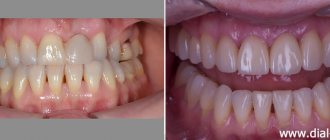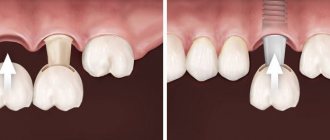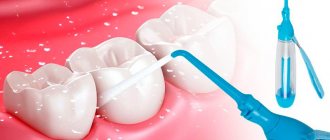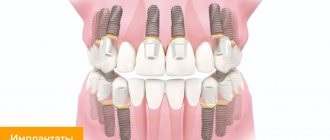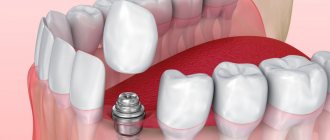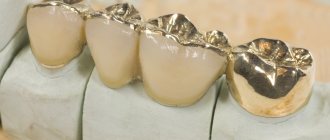A bridge is a fused orthopedic structure used to replace one or more missing teeth in a row, usually one to three. Before the advent of implantation, bridges were used everywhere. In terms of their advantageous characteristics, classical bridges are unlikely to be able to compete on equal terms with implantation. However, each technique has its own disadvantages and contraindications, so the choice is made after analyzing a number of factors.
Pros of installing an implant
During implantation, the artificial root serves as a support for the crown. Most often, high-strength titanium is used, which ensures complete inertness. This eliminates the risk of rejection and allergic reactions. Implants fully perform the functions of teeth: they restore chewing efficiency, are responsible for uniform load on the jaw bone, and maintain the shape of the gums. The appearance of an artificial neighbor does not affect the units located nearby, since titanium structures are implanted into the jaw bone, after which a crown or bridge is installed on them.
- reliability, strength, durability of structures;
- over time, bone tissue does not atrophy;
- no need to remove pulp from adjacent units;
- With proper care they can last a lifetime.
- relatively high cost;
- the presence of contraindications (diseases of the circulatory system, oncology, HIV, decompensated diabetes mellitus, diseases of the immune and endocrine systems, scleroderma, lupus erythematosus, etc.);
Caring for implant bridges
A brush, paste, rinse and irrigator are the main tools to achieve excellent oral hygiene every day. After each meal, you should rinse your mouth to remove food debris with water or mouthwash. After implantation, the gums become less sensitive, so you should use super-floss carefully.
It is necessary to visit the doctor once every six months for a preventive examination. It is also advisable to carry out comprehensive professional cleaning at least once a year.
Author:
Pros and cons of classic bridges
- Not bad functionality.
- Fewer contraindications compared to implantation.
- In terms of cost, this is a more budget-friendly restoration option.
- The need for turning. The procedure usually requires depulpation of healthy supporting teeth.
- Lack of load provokes bone tissue atrophy.
- Mediocre aesthetics.
Advantages and disadvantages of a bridge on implants
Advantages:
- Healthy teeth are not affected;
- the life of your teeth is extended;
- there is a uniform distribution of chewing pressure;
- the process of jaw bone loss slows down;
- smooth aesthetic gingival margin;
- the structure is firmly fixed;
- end defects are eliminated;
- long service life (over 10 years).
Flaws:
- A 100% loss of bone tissue cannot be ruled out;
- the price is higher than that of classical prosthetics.
Bridge or implant on the front tooth?
When restoring teeth in the smile area, implantation is recommended. If several teeth are missing at once, it is better to replace them separately (one tooth - one implant). However, an option with a bridge prosthesis is also possible, but with support on artificial roots, and not on the patient’s own teeth. A combination of two techniques (implantation and bridge installation) is used in cases of the absence of several teeth in a row or their complete loss. In this case, the number of supporting implants depends on the duration of the bridge structure. This method of restoration eliminates the grinding of healthy teeth and ensures a reliable connection of the prosthesis to the jaw. Dentures on implants last longer than bridges installed on natural teeth.
Classic bridges on the front teeth are also one of the solutions, especially in the case of absolute contraindications to implantation or with limited financial resources. Modern bridges can be made of solid ceramics or zirconium: for front teeth this will be the best option, but it will be more expensive than conventional metal-ceramics.
Indications and contraindications for installing a bridge on implants
We recommend implant bridges to patients:
- In the absence of the last teeth in a row - when there is no natural support for the prosthesis, and without installing a titanium rod, restoration of the defect is impossible;
- if several units are lost in a row - to preserve the teeth next to the defect and minimize the load on the bone;
- with complete edentia or multiple absence of teeth - when most or all of the teeth in a row are missing.
Implantation is a complex surgical operation with its own limitations. Therefore, our specialists examine the patient before the procedure to identify possible contraindications:
- Acute form of periodontitis;
- violation of the cardiovascular, immune, endocrine systems;
- uncompensated diabetes mellitus;
- tuberculosis;
- blood diseases;
- mental disorders;
- malignant formations.
The operation is postponed during pregnancy and lactation. It is not carried out in patients who abuse smoking and alcohol.
What to choose for chewing teeth?
In the case of chewing teeth, functionality comes to the fore. A dental implant can withstand chewing loads one hundred percent. In the case of a classic bridge, all the “work” falls on the natural teeth on which the prosthesis is attached. Experiencing additional stress, over time, the supporting teeth are destroyed and deformed.
Complications after bridge installation
If the patient nevertheless decides to install bridge structures, it is important for him to know about the following possible consequences of this method of prosthetics:
- Often, after dentures, patients begin to experience discomfort due to the adaptation of taste buds to the voids in the mouth. This may take several days.
- Unpleasant sensation from food getting under the denture. This is natural, since after prosthetics there is always a gap between the gum and the mouth, the so-called “washing space”. If the denture is placed tightly against the gums, this will lead to the formation of bedsores. You should see a dentist if the rinsing space is excessively large or if the prosthesis touches the gum at some point. Most often, the constant entry of food under the denture causes the destruction of the filling of the adjacent tooth or the new crown.
- To remove food debris, the patient must accustom himself to using a toothbrush, irrigator or superfloss.
- An unpleasant feeling of excessive convexity of the bridge at some points. It seems to the patient that in some places something is preventing the movement of the jaws. Such a nuisance can cause splitting of the denture or pain in the area of the supporting teeth. Therefore, in such cases, it is necessary to correct the protruding places of the structures at the dentist.
- Exposure of the neck of the tooth some time after the installation of bridges. This phenomenon can be considered a natural process due to the “creeping” of the gums. This unpleasant process can develop accelerated due to pathological processes of the gums or improper grinding of teeth (without the formation of a special ledge). To slow down the exposure of the gums, crowns are made from biocompatible materials with all-metal edges.
- Crowns often fall off in patients suffering from bruxism. With this disease, many types of prosthetics are contraindicated, since crowns and veneers may come off.
Dental bridge or implant - which is better from an economic point of view?
The question of what to install (a bridge or an implant) in the event of the loss of one or more teeth is also relevant from a financial point of view. If you are on a limited budget and cannot afford to restore your teeth with implants, choose bridge structures. But keep in mind that classic bridges have a limited service life and need to be replaced over time. In the long term, implantation is a more profitable option for restoring teeth, despite the fact that implant-supported dentures are the most expensive. For example, one budget category implant and metal-ceramic crown will cost approximately 35,000 rubles: premium implants and prostheses can double this amount.
Classic bridges are cheaper: the price for a bridge of three crowns starts from 30,000 rubles. Designs made of ceramics and zirconium dioxide will cost more. For example, a ceramic bridge made using E-max technology costs from 60,000 rubles. Agree, this amount does not fit into the budget solution. In addition, the price of installing a classic bridge does not include the cost of preparing supporting teeth, while depulpation of one molar can cost more than 5,000 rubles. Add to this amount further expenses for replacing the prosthesis. As a result, the cost of a conventional bridge will be comparable to the cost of implantation.
Comparison of methods by characteristics
Prosthetics on implants and a bridge have a number of fundamental differences. Each technique has advantages and disadvantages. The doctor chooses the technology after assessing all factors.
Advantages
Implants are able to withstand increased chewing loads, distributing them evenly across the jaw, due to this they are not destroyed during operation. Unlike classic bridges on your teeth, which require systematic re-cementing, implants are implanted once and for life.
In the case of classic bridges, the load falls on the supporting teeth. This can lead to their gradual destruction and removal. The size of the prosthesis will increase until there are no units left to act as support. At the site of the defect, bone tissue atrophy will continue. Implantation solves this problem.
Flaws
The main disadvantages of implantation include:
- high cost - but considering that implants are installed for life, the costs are justified;
- many contraindications - currently the list of contraindications has decreased, new technologies have been developed;
- treatment period (if a two-stage protocol with delayed loading is used, accompanied by osteoplastic intervention) - one-stage technologies will allow you to restore the dentition in 1-3 days.
Installation of a bridge requires the preparation of two supports. It’s sad if you have to injure healthy units. Due to the uneven redistribution of mechanical load, bone tissue atrophy accelerates, the contour of the gum changes and sags. A gap appears between the bridge and the gum where bacterial plaque and food particles accumulate. Not all prosthetic structures are subject to repair and relocation. Teeth under crowns are subject to secondary caries, which will lead to rapid tissue destruction and an increase in the length of the defect.
Contraindications
Implantation is a surgical procedure with some contraindications. But unlike the classic bridge, a number of protocols can be used for serious periodontal pathologies, problems with bite, occlusion, and a complicated medical history.
Both methods are contraindicated in:
- inflammatory process of the oral cavity;
- infections in the acute stage;
- chronic diseases in the stage of decompensation.
Absolute contraindications to implantation include oncology and severe bleeding disorders. A bridge is not installed in cases of terminal and long-term defects (loss of 4 units in a row or more), malocclusion pathologies, or low height of dental crowns.
Possible complications
The survival rate of implant structures is 98-99.9%. But in rare cases, complications are possible - peri-implantitis (inflammation of the tissue around the implant), rejection of the artificial root. Engraftment of the implant structure requires the professionalism of the doctor and the patient’s compliance with the instructions in the postoperative period and beyond.
After installing a bridge structure, the neck of the supporting teeth may be exposed due to subsidence of the gums. With bruxism, restorations may fall out of the prosthesis. Due to improper redistribution of mechanical load, the bridge wears out faster, the supports under it become loose and shift.
Life time
The manufacturer indicates the service life of the implant is 20 years or more. With proper care and regular dental care, an artificial root will last a lifetime . An orthopedic structure installed on implants requires replacement no earlier than after 10-25 years (structures made of zirconium dioxide - 20 years and above).
The service life of a dental bridge, due to rapid wear due to bone subsidence, averages 6-10 years (depending on the material).
Price
When considering the question of what is cheaper, a bridge or an implant, we focus on the long term.
- Installing a metal-ceramic bridge of three artificial crowns costs 20-25 thousand rubles. per unit , zirconium - 40-60 thousand rubles per unit . Preparation is paid separately - depulpation of 2 support units costs 10-18 thousand rubles.
- Installation of a classic ROOTT implant on a turnkey basis costs 28 thousand rubles. , plus a metal-ceramic crown 28 thousand rubles. (zirconium - 35 thousand).
The final price of prosthetics is not too different. Considering that the bridge will have to be re-cemented every 6-10 years, which may require treatment and restoration of supporting units, implantation will allow for a more cost-effective restoration of the dentition.
What are implants
Implants are considered the most modern and reliable way to replace missing teeth. Although this method is not cheap, thanks to it you can forget about dental problems for a couple of decades.
The implant itself consists of three main parts: a crown (fixed on a pin), an abutment (the junction of the upper part of the prosthesis and the root) and an artificial root (usually made of titanium alloys).
Typically, patients resort to installing implants in the following cases:
- in the absence of contraindications;
- if you do not want to install removable dentures;
- wanting to do without grinding the supporting teeth.
Most often, modern orthodontists advise their patients to install screw implants. This model is a type of screw that is screwed into the jawbone as a base for attaching a crown.
Most often, a patient receives as many implants as there are missing teeth. When using implants, bridges are very rarely used as a basis for crowns. This happens because an ordinary tooth is attached to the socket with the help of ligaments, which provide it with the necessary mobility. An artificial implant is firmly fixed and has no natural mobility. Therefore, each such non-removable structure is attached to its own separate hole, helping to properly distribute the food load and without injuring the jaw bone.
Which is cheaper: an implant or a bridge?
The cost of methods to combat edentia depends on:
- regional localization of the clinic;
- level of qualification of specialists;
- quality of materials and equipment.
Naturally, regional centers provide services cheaper than capital ones. In Moscow clinics, one implant can be installed for 20-90 thousand rubles; in a district hospital, doing the same procedure will be cheaper. The situation is the same with prosthetics. In the capital, you can install a bridge for 10 thousand rubles, in the regions - for 7 thousand.
Here is a comparative table of prices for two methods of dental restoration, based on the materials used:
| Type of service | Cost, rub. |
| Implants (1 unit without crown) | |
| Osstem | from 20000 |
| Alpha Bio | from 21000 |
| M.I.S. | from 23000 |
| Implantium | from 26000 |
| Nobel Biocare | from 45000 |
| Astra Tech | from 45000 |
| Bridge prosthesis (1 unit) | |
| Metal ceramics | 7000-19000 |
| Ceramics | 15000-43000 |
| Zirconium dioxide | 20000-45000 |
What materials are they made of?
Dentures are manufactured in the Center’s own dental laboratory, you can choose the appropriate option to suit your taste and budget
- Metal-ceramic The base of the crowns is a metal alloy, the top is covered with ceramic mass. Relatively inexpensive, yet durable and quite aesthetic. The main disadvantage of metal ceramics is the ability to oxidize and cause a bluish outline to appear on the gums over time. Service life - 15 years or more .
- Zirconium Can be all-zirconium or coated with ceramics. They can withstand any load, do not deform, and retain their original appearance. Identical to natural teeth, the shade is selected individually. More expensive than metal-ceramic ones, but last longer. Service life - 25 years or more.
We offer patients the most profitable and practical methods, so we reserve the advantage for metal-free structures. In our Center, dental bridges are created in our own digital production using Zirkonzahn Schule technology or at the PROCERA (Nobel Biocare) plant in Sweden.
Complications after installation of implants
Unfortunately, occasionally (in 5% of cases) implantation can cause various complications. They can occur during the implantation operation, immediately after it, and after some time.
Most often, patients may encounter the following types of postoperative complications:
- bleeding (with low blood clotting);
- pain:
- seam divergence;
- perforation in the maxillary sinus (usually as a result of insufficient examination before implantation in the upper jaw);
- paralysis of the masticatory muscles after damage to the mandibular nerve;
- inflammatory process at the incision site;
- peri-implantitis (severe complication in the form of inflammation around the implant and its rejection).
In case of any trouble (pain, suture dehiscence, inflammation or bleeding), it is important for the patient to immediately call his doctor.
Prescribed hygiene and proper treatment of the postoperative wound are also important.
Peri-implantitis is more often observed in the first months after surgery. Occasionally, this extremely unpleasant consequence occurs much later for various reasons (prosthetic errors, burns during surgery or postoperative inflammation, bone pathology or patient diseases).
Occasionally, incorrect installation of implants also occurs, which seriously complicates further prosthetics. This is why it is important for an orthopedist and a surgeon to work as one team.
An experienced orthodontist can help the patient determine the appropriate implant design. We wish you to make the absolutely right choice!
Sources used:
- Ireland, Robert IrelandRobert (2010), Ireland, Robert (ed.), "Denture stomatitis", A Dictionary of Dentistry
- “Removable dentures: a textbook” (Mironova M.L.)
- “Partial removable dentures” (Zhulev E.N.)
- Glass, R; Goodson, L; Bullard, J; Conrad, R (2001). "Comparison of the effectiveness of several denture sanitizing systems". Compendium of Continuing Education in Dentistry.
What to choose in the end
So, to summarize:
- The dentist installs the rod without involving neighboring teeth in the operation process. The bridge requires grinding and depulping healthy units that could serve for a long time.
- Often bridge structures are characterized by incomplete tightness. Fragments of food fall under them, and this is excellent food for bacteria. In such a situation, they will quickly destroy the supporting molars. So what remains? Remove teeth! Most patients, having learned this information, immediately decide what to install, a dental bridge or an implant on a chewing tooth. It’s easy to choose, of course, an artificial rod with a crown!
- Strict adherence to the rules of care for implants makes it possible to use them throughout your life. Bridges tie the patient to regular visits to the orthodontist.
- Bridge structures negatively affect both the supporting units and the health of the whole series. After all, all the teeth in the mouth must be evenly loaded so that there is no loosening or displacement. Unfortunately, there is no need to talk about a uniform load with bridge systems.
- The bridge leads to the resorption of the hard tissues of the jaw in the area where the units are missing. This is fraught with serious consequences: changes in appearance, reduction of the lower part of the face, a senile mouth, thinning of the lips. It happens that after removing the bridge, it is no longer possible to install an artificial rod. Sometimes only bone grafting will correct the situation.
- After some time, with bridge-like structures, the necks of the teeth are exposed, as the gums sag.
Many difficulties in the presence of bridge structures are typical. Obviously, the use of bridges is associated with major disadvantages compared to implants. Therefore, many dentists prefer artificial rods with crowns. This applies to both frontal units and molars. You can get acquainted with the material in more detail on the page “Masticatory tooth implant. The choice is, of course, yours. But specialists who use advanced technologies install bridge-like devices in extreme cases.
Advantages of implants
In modern European countries, implantation systems are considered the priority type of prosthetics. This type of treatment is used even in cases of large or complete absence of teeth.
In developed European countries, a doctor does not have the right to offer a patient the installation of a bridge where it is possible to install an implant. Otherwise, he will be deprived of his license to engage in private practice.
Unlike bridge structures, implant systems completely restore the function of missing teeth (front and chewing) and meet the high aesthetic requirements of patients.
Also, the advantages of installing implants include:
- the possibility of their long-term use (often a lifetime guarantee) due to the presence of strong artificial roots made of titanium alloy.
- fast prosthetics – most often the whole process takes up to 2 months, and sometimes modern implants are installed in one stage immediately after tooth extraction;
- the ability to do without turning and depulping, keeping the abutment teeth unharmed;
- ideal distribution of food load on the gingival bone, comparable to natural and the ability to protect the gums and jaws from atrophic changes;
- the ability to select a crown with a full selection of shades to match the natural color of the patient’s tooth enamel;
- excellent survival rate of structures (96-98%) due to the use of hypoallergenic materials;
- the possibility of using implants as a support for fastening for clasp and bridge-like removable structures.
It is important to install an implant as soon as possible after tooth loss. This helps keep the dentures from sagging and forget for a long time about the issues associated with repeated prosthetics.
How to put a bridge on teeth
Manufacturing and installation take place in several successive stages:
- Sanitation of the oral cavity is carried out. The dentist must treat caries and eliminate other problems; it is important to get rid of all pathological processes. Particular attention should be paid to units that will subsequently serve as support. They are depulped (nerves are removed and the canals are cleaned), then filled. Then grinding is performed to securely fix the crown elements. This manipulation is called preparation.
- The doctor selects the shade. The main criterion is the color of the enamel of all rows in the mouth; the patient’s personal preferences are also taken into account.
- Impressions are taken of both jaws. In this case, it does not matter whether the upper or lower one is restored.
- In laboratory conditions, a corrective product is manufactured according to individual parameters. On average, this process lasts 2-3 weeks. During this time, it is recommended to wear plastic models.
- When ready, fitting and fitting are performed. If necessary, everything is returned for revision.
Fixation is carried out only if the person does not experience discomfort when putting on and taking off. The dentist must ensure that the bite and row closure are correct. In addition, compatibility with the natural enamel layer is assessed by shade.
The unit is attached to special medical cement. Upon completion of the procedure, the patient receives recommendations for proper care.

